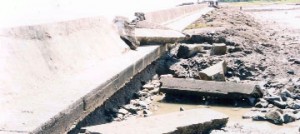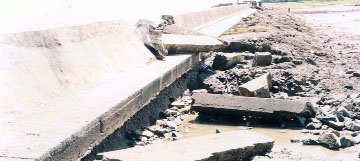By Maya Trotz
Maya Trotz teaches environmental engineering at the University of South Florida, Tampa.
In the aftermath of hurricanes Gustav and Hanna, Dr. Paul Farmer, co-founder of Partners in Health (an international health and social justice organization), wrote an open letter detailing the devastation visited upon northern and central Haiti and the city of Gonaives in particular (http://www.pih. org/inforesources/news/PEF_hurricane_letter.html). One day after his letter was posted, Hurricane Ike visited more death and misery on the people of Haiti.

In the aftermath of Katrina, investigations into levee failures in New Orleans have raised questions of adequate investment into public works, pointed fingers at the US Army Corps of Engineers and its contractors, and even discussed possibly changing or redirecting waterways. In 2008, Hurricane Gustav and Ike saw massive evacuation efforts along the borders of the US Gulf coast as flood predictions were made against the backdrop of a growing and widespread awareness of the vulnerability of the infrastructure.
Although on a much vaster scale, images from Gonaives of flooded homes and streets, decaying animals floating in waters, tired women, men and children wading the streets in search of food, will be familiar to Guyanese on the coast, who vividly remember the floods of January and February 2005. It is a fact that the low lying coastal zone where 90% of Guyana lives floods because it is below sea level. Yet what we faced in 2005 is in so many ways also an unnatural disaster. In other words, our natural vulnerability notwithstanding, our sea defenses and drainage systems are operating below an optimum desired level, especially when the sea wall “washes away”, the koker operator whose annual salary is USD$138 forgets to “close the koker” during high tide, or the drains just “silt up”.
There is no doubt that Guyana’s sea defenses are vulnerable to even daily “high tide” in some areas, much less a major climate event. With funds provided by the European Development Fund, there appears to be a $1.15 million Euro tender out to provide technical services for supervision of sea wall reconstruction of approximately 1.5 km in Guyana, to begin in March 2009. Capacity building projects targeting governmental workers and university students have also received funding in the past and in 2007 some $789 million Guyana dollars were spent on sea defence. All this seems like a drop in the bucket, a patchwork of repair efforts, in the face of the crumbling realities of a sea defence system that has not been systematically maintained for so long.
In Guyana in 2005 we had no plan, and many were not aware of the vulnerability of the conservancy, much less how huge an impact its failure could have on the coast. Given that experience one must now ask, what is our natural disaster plan in the face of another flood (it is not a question of if, but a matter of when) and who knows about it? Additionally, is a discussion of the work that is needed being undertaken in consultation with communities, or are we overlooking an opportunity to collectively learn from each other about a matter that is critical to the protection of our very existence as coastal dwellers? Some may argue that sea defence projects are for experts and beyond the understanding of regular citizens. This misses the point that it is the villagers who are often the first to sandbag a breach, the small farmers who can identify the intricate networks of canals and trenches upon whose proper operation their livelihoods depend, the individuals who unfortunately harvest or clear the mangroves that remain the most natural form of protection along the coast, the women who during the floods must figure out how to keep drinking water clean for their families, the citizens who uncaringly throw rubbish into our drains. In other words, we need to recognize, value and tap into local ways of knowing that have sustained us for generations, and understand that some of our own actions are also part of the problem that needs to be solved. Active and meaningful engagement is the only way we can effectively reduce – we will never be able to eliminate – the impact of a natural disaster along our coast, a coast that some may even argue we should retreat from. In the face of the avoidable and tragically unnatural consequences visited upon Haiti and other places by natural disasters, we should think about our “interconnectedness” and ask ourselves whether we are really going to let these opportunities for informing each other pass us by until the waters rise at our feet again?






